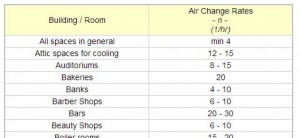The first question is, “why is this useful?“. Well, generally speaking, it is helpful to know if you are getting bare-minimum airflow, or if you are creating a wind tunnel on your project. Since many construction projects are not able to mobilize until the last minute, it is useful to make some rough guesstimates and calculate the airflow in the room. One squirrel-cage fan isn’t going to ventilate a warehouse, and 5 of them in a manhole will make welding impossible.  so…moving on.
Air changes per hour (ACH) is a function of the room size and the airflow into/out of the room. It is simply the number of times the volume of air is changed out over a one hour time period. One reason this calculation is so attractive to use is because there are recommended exchange rates for different environments. Some of them can be seen in the picture, the rest can be found here.
To calculate you must know:
- A = Volume of room in cubic feet (ft3)
- Q = Air flow of your fan (s) in cubic feet per minute (CFM)
Rather than reinvent the wheel Wiki has a good summary.
Caveat/Disclaimers. There are quite a few…so be careful.
- Mixing. The air never really mixes when you are exchanging air in this manner. It is dilution ventilation. So,
- Never use this method for any hazardous source, and
- Never use this for any carcinogens (asbestos, benzene, etc).
- Airflow into & out of the space is required, and is never ideal. Make sure there is space for the air to actually exchange.
- Make sure your fans work properly and do provide the manufacturers output.